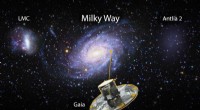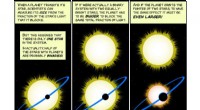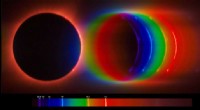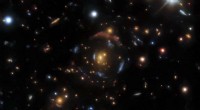
Wetenschap
Verrassende details springen eruit in scherpe nieuwe James Webb Space Telescope-beelden van Jupiter
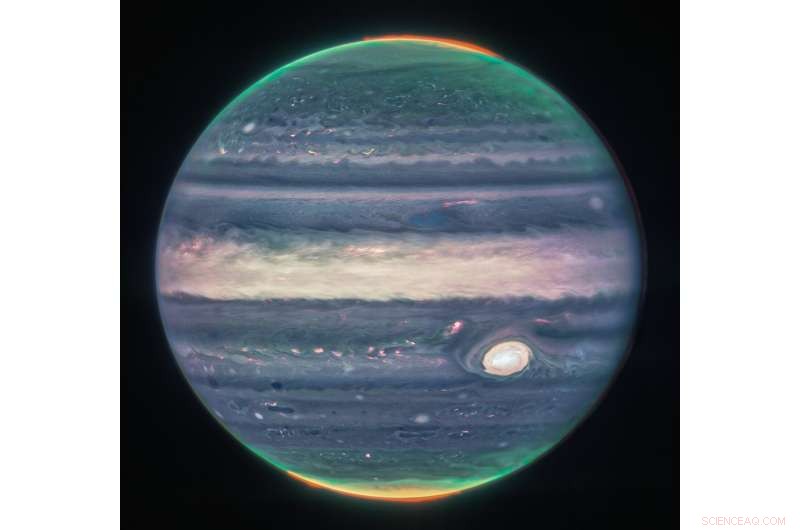
James Webb Space Telescope-beelden van Jupiter laten een verbluffende rijkdom aan details zien. Een filter dat gevoelig is voor poollichtemissie van geïoniseerde waterstof (in kaart gebracht in het rode kanaal) onthult poollichtovalen op de schijf van de planeet die zich uitstrekken tot grote hoogten boven zowel de noord- als de zuidpool. Een ander filter dat gevoelig is voor nevels op grote hoogte (in kaart gebracht in het groene kanaal) benadrukt de polaire nevels die rond de noordelijke en zuidelijke polen wervelen, terwijl een derde filter het licht benadrukt dat wordt gereflecteerd door de diepere hoofdwolk (in kaart gebracht in het blauwe kanaal). De Grote Rode Vlek, het equatoriale gebied en compacte (inclusief minuscule) wolkengebieden lijken wit (of roodachtig wit) op deze afbeelding met valse kleuren. Regio's met weinig bewolking verschijnen als donkere linten ten noorden van het equatoriale gebied. Andere donkere gebieden hier, zowel naast de Grote Rode Vlek als in cyclonale kenmerken op het zuidelijk halfrond, zijn ook donker gekleurd wanneer ze worden waargenomen in zichtbaar licht. Credit:NASA, European Space Agency, Jupiter Early Release Science-team. Beeldverwerking:Judy Schmidt
De nieuwste beelden van Jupiter van de James Webb Space Telescope (JWST) zijn verbluffend.
De infraroodbeelden, die op 27 juli werden vastgelegd, zijn kunstmatig gekleurd om specifieke kenmerken te laten opvallen en tonen fijne filigraan langs de randen van de gekleurde banden en rond de Grote Rode Vlek en bieden ook een ongekend zicht op de aurora's boven de noord- en zuidpool.
Eén groothoekopname toont een unieke line-up van de planeet, zijn zwakke ringen en twee van Jupiters kleinere satellieten - Amalthea en Adrastea - tegen een achtergrond van sterrenstelsels.
"We hebben Jupiter nog nooit zo gezien. Het is allemaal vrij ongelooflijk", zei planetaire astronoom Imke de Pater, emerita professor van de University of California, Berkeley, die samen met Thierry Fouchet, een professor aan de Paris Observatorium. "We hadden eerlijk gezegd niet verwacht dat het zo goed zou zijn. Het is echt opmerkelijk dat we details op Jupiter samen met zijn ringen, kleine satellieten en zelfs sterrenstelsels in één afbeelding kunnen zien."
De Pater, Fouchet en hun team hebben de beelden vandaag (22 augustus) vrijgegeven als onderdeel van het Early Release Science-programma van de telescoop.
-
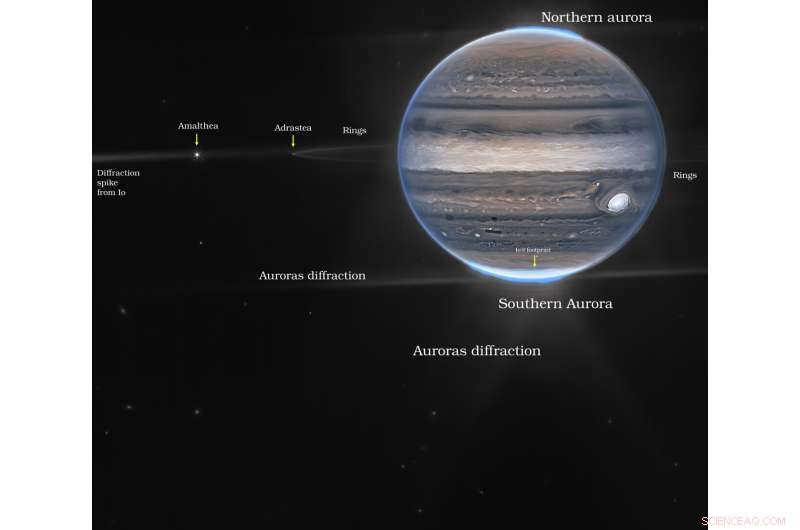
Dit composietbeeld met valse kleuren van Jupiter werd verkregen met het NIRCam-instrument aan boord van de James Webb Space Telescope op 27 juli 2022. Het breedveldkleurenschema verschilt van het kleurencomposiet omdat deze beeldvormingsmodus verschillende belichtingstijden en slechts twee filters gebruikte, in kaart gebracht in oranje en cyaan kleuren. De afbeelding toont de ringen van Jupiter en enkele van zijn kleine satellieten samen met achtergrondstelsels. Amalthea (~ 250 x 150 km breed) en kleine Adrastea (~ 20 km breed) zijn zichtbaar in deze afbeelding. The diffraction pattern created by the bright auroras, as well as the moon Io (just off to the left, not visible in the image), form a complex background of scattered light around Jupiter. Credit:NASA, European Space Agency, Jupiter Early Release Science team. Image processing:Ricardo Hueso [UPV/EHU] and Judy Schmidt
-
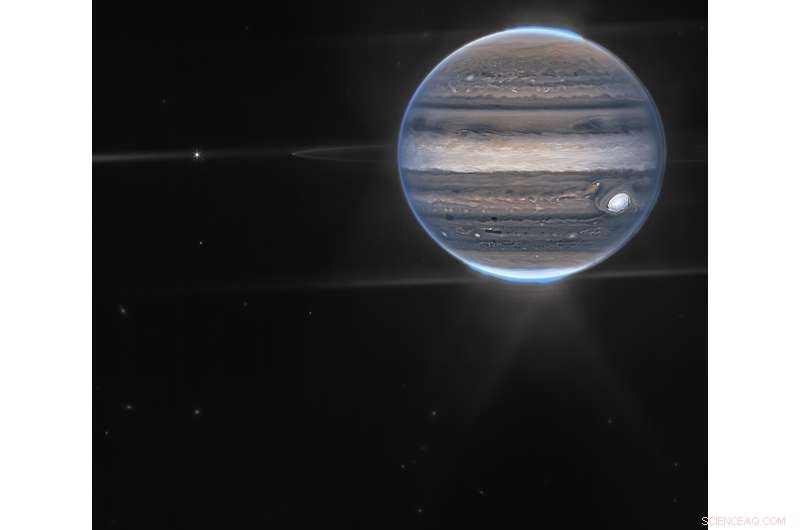
This false color composite image of Jupiter was obtained with James Webb Space Telescope's NIRCam instrument on July 27, 2022. A combination of short and long exposures in F212N (mapped to an orange color) and F335M (mapped to cyan) show Jupiter's rings and some of its small satellites together with background galaxies. Amalthea (~250 x 150 km across) and tiny Adrastea (~20 km across) are visible in this image. The diffraction pattern created by the bright auroras, as well as the moon Io (just off to the left, not visible in the image), form a complex background of scattered light around Jupiter. Credit:NASA, European Space Agency, Jupiter Early Release Science team. Image processing:Ricardo Hueso [UPV/EHU] and Judy Schmidt
In addition to the enormous storm referred to as the Great Red Spot, numerous storm systems—seen as small pallid ovals —are also visible, as are tiny bright plumes of cloud particles. The transition between organized zonal flows and the chaotic vortex patterns at higher latitudes is also clearly visible.
"Although we have seen many of these features on Jupiter before, JWST's infrared wavelengths give us a new perspective," said de Pater. "JWST's combination of images and spectra at near- and mid-infrared wavelengths will allow us to study the interplay of dynamics, chemistry and temperature structure in and above the Great Red Spot and the auroral regions."
Amalthea and Adrastea
JWST's Near Infrared Camera (NIRCam) also captured a wide-field view of Jupiter revealing its rings and two of its moons.
"This image illustrates the sensitivity and dynamic range of JWST's NIRCam instrument," Fouchet said. "It reveals the bright waves, swirls and vortices in Jupiter's atmosphere and simultaneously captures the dark ring system, 1 million times fainter than the planet, as well as the moons Amalthea and Adrastea, which are roughly 200 and 20 kilometers across, respectively. This one image sums up the science of our Jupiter system program, which studies the dynamics and chemistry of Jupiter itself, its rings and its satellite system."
The JWST images were processed with the help of citizen scientist Judy Schmidt of Modesto, California, who has worked with Hubble Space Telescope and other telescope images for the past 10 years, and Ricardo Hueso, who studies planetary atmospheres at the University of the Basque Country in Spain. Hueso is one of several coinvestigators on the Early Release Science (ERS) program, and is leading the NIRCam observations of Jupiter's atmosphere.
Schmidt's love of astronomy images has led her to process images of nebulae, globular clusters, stellar nurseries and more spectacular cosmic objects.
"Something about it just stuck with me, and I can't stop. I could spend hours and hours every day," she said. Her goal, she added, is to "… try to get it to look natural, even if it's not anything close to what your eye can see."
Spectroscopic observations of Jupiter's auroras are scheduled for later this year, while detailed spectroscopic observations of Jupiter's Great Red Spot were taken on July 27 in the near-infrared and August 14-15 at mid-infrared wavelengths. The Great Red Spot observations are a joint project between the Early Release Science (ERS) team—with de Pater and Fouchet as co-principal investigators—and a program of Solar System observations developed by Heidi Hammel of the Association of Universities for Research in Astronomy (AURA), with the Jupiter observations led by Leigh Fletcher, a professor at the University of Leicester in England.
Other UC Berkeley members of the ERS team for Jupiter observations are research astronomer Mike Wong and postdoctoral fellow Ned Molter. + Verder verkennen
NASA releases Webb images of Jupiter
 Geavanceerde beeldvorming onthult ongebruikelijke, onzichtbare patronen in veren van zeevogels
Geavanceerde beeldvorming onthult ongebruikelijke, onzichtbare patronen in veren van zeevogels De opmerkelijke variabiliteit van elektronische structuren van actinidetetrafluoride
De opmerkelijke variabiliteit van elektronische structuren van actinidetetrafluoride Water halen uit inkt, melk en azijn
Water halen uit inkt, melk en azijn Zonnetoren stelt materialen bloot aan intense hitte om thermische respons te testen
Zonnetoren stelt materialen bloot aan intense hitte om thermische respons te testen Chemici creëren nieuwe route naar PHA's:natuurlijk afbreekbare bioplastics
Chemici creëren nieuwe route naar PHA's:natuurlijk afbreekbare bioplastics
 EU wil miljoenen mensen betere toegang tot drinkwater geven (Update)
EU wil miljoenen mensen betere toegang tot drinkwater geven (Update) Decennia geleden lekt er nog steeds methaan uit de grond op de plaats van de gasexplosie
Decennia geleden lekt er nog steeds methaan uit de grond op de plaats van de gasexplosie Geef de shiraz door, alsjeblieft:hoe de Australische wijnindustrie zich kan aanpassen aan klimaatverandering
Geef de shiraz door, alsjeblieft:hoe de Australische wijnindustrie zich kan aanpassen aan klimaatverandering Bosbranden in Californië treffen Hollywood-beroemdheden, te
Bosbranden in Californië treffen Hollywood-beroemdheden, te Een fijnkorrelig beeld van stofstormen
Een fijnkorrelig beeld van stofstormen
Hoofdlijnen
- Hier is hoe planten- en dierencellen verschillen
- Sneeuwuilaantallen veel lager dan ooit gedacht
- Biologen maken kever met functioneel extra oog
- Hoe slaap werkt
- Belangrijke plantensoorten kunnen belangrijk zijn voor het ondersteunen van bestuivers van wilde bloemen
- Waarom zijn chromosomen belangrijk voor celdeling?
- Celgroei en -deling: een overzicht van mitose en meiose
- Evolutie van parasietvirussen geeft aan hoe Leishmania voor het eerst gewervelde dieren heeft geïnfecteerd
- 10 misvattingen over GGO's
 Sentinel-1 doorziet orkanen
Sentinel-1 doorziet orkanen Microsoft geeft glimp van nieuwe Xbox-console
Microsoft geeft glimp van nieuwe Xbox-console Uit eten, inademen
Uit eten, inademen De methaanlekken van boilers zijn hoog, maar fixable
De methaanlekken van boilers zijn hoog, maar fixable De lockdown van februari in China zorgde voor een daling van sommige soorten luchtvervuiling, maar anderen niet
De lockdown van februari in China zorgde voor een daling van sommige soorten luchtvervuiling, maar anderen niet Mississippi Delta moerassen in een staat van onomkeerbare ineenstorting, studie toont
Mississippi Delta moerassen in een staat van onomkeerbare ineenstorting, studie toont Hoe voorspellers orkaan Dorian volgen
Hoe voorspellers orkaan Dorian volgen Wat is een rivieroverstroming?
Wat is een rivieroverstroming?
- Elektronica
- Biologie
- Zonsverduistering
- Wiskunde
- French | Italian | Spanish | Portuguese | Swedish | German | Dutch | Danish | Norway |

-
Wetenschap © https://nl.scienceaq.com

